Expert Advice
Tips for Covering Moving Water While Fly Fishing
The Challenge
Learning to successfully fly-fish in moving water can be a challenge for many as it is far more difficult than fishing in stillwaters. The main reasons for this are the numerous different water conditions that present themselves on any given day. Observing the flow of the water is important to achieve success in a river as it plays a role in where fish will hold based on water levels. Knowing the proper terminology of the water is important to achieve success as helps you better understand a rivers movement. The following is a list of some of the common portions of a river you will encounter in most river systems.
• The Zone – The area in which fish will hold or pass through.
• Tail-out – The wide shallow water at the end of a run.
• Headwater – The start or top end of a run.
• Slot – A long narrow area where the water is deeper.
• Seam – An area where the slow and fast water meet.
• Slick – An area where the surface water is calm.
• Riffle – An area where the water is generally quick and shallow.
• Eddie – The turning water behind some form of structure.
• Pocket-water – A small piece of behind some form of structure.
• Depression – An indentation on the bottom in the sand or gravel.
• Frog-water – An are of the river where the flow is very slow or stagnant
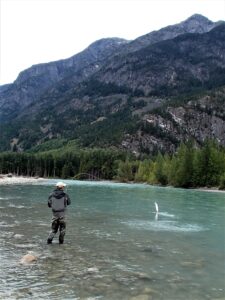 Unlike in a lake where fish swim freely throughout the entire water column, in rivers the areas that hold fish are often quite limited. Even something as unpredictable as the weather can greatly change the day’s tactics. When it rains heavy, water levels come up and fish will hold in the head or tail of a run. If the water is low and clear fish will sit in the middle of the run seeking out shelter in the deeper water. As for shelter, fish will often hold along side logs, rocks and even along the edges of under-cut banks. When a river doesn’t contain a lot of natural structure, fish are usually located in the deeper parts of the river. On many occasions fish will hold in a depression in the gravel. Holding in these low spots allows the rivers current to pass over the fish allowing them to exert a lot less energy.
Unlike in a lake where fish swim freely throughout the entire water column, in rivers the areas that hold fish are often quite limited. Even something as unpredictable as the weather can greatly change the day’s tactics. When it rains heavy, water levels come up and fish will hold in the head or tail of a run. If the water is low and clear fish will sit in the middle of the run seeking out shelter in the deeper water. As for shelter, fish will often hold along side logs, rocks and even along the edges of under-cut banks. When a river doesn’t contain a lot of natural structure, fish are usually located in the deeper parts of the river. On many occasions fish will hold in a depression in the gravel. Holding in these low spots allows the rivers current to pass over the fish allowing them to exert a lot less energy.
The Obstacles
Whether you use a single-handed rod or a two-handed rod, when fly-fishing moving water knowing what’s going on below the surface is essential. The surface often gives you a great indicator on what’s going on below. If the surface is broken it is because there is some form of structure on the bottom that has changed the natural flow of the water. Swinging a fly through the broken water will often result in a strike as fish are patently waiting there for food to come to them. Once a fish is hooked in a specific type of water you will often find more fish in similar water further up or down river. When covering moving water, you must always know where your fly is at any given time. Mending your fly line in moving water is essential as it allows your rod tip to follow your fly through the current. If you are not in control of your line a fish will pick up your fly and drop it before you even realize you had a strike.
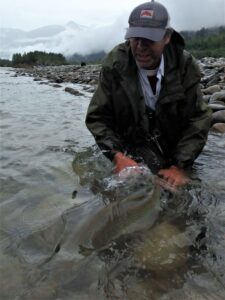 Most anglers know that fish like to hide behind large rocks and boulders in a river but adequately covering them with a fly can be a challenge at times. Fortunately for us, fly line manufactures have developed excellent lines to cover the numerous challenges presented to a river fisherman. Over the years I streamlined my river lines to three choices.
Most anglers know that fish like to hide behind large rocks and boulders in a river but adequately covering them with a fly can be a challenge at times. Fortunately for us, fly line manufactures have developed excellent lines to cover the numerous challenges presented to a river fisherman. Over the years I streamlined my river lines to three choices.
The Tools
The first and most important is a full floating line. This line will enable me to use dry flies, nymphs and even strike indicators if desired. Indicator fishing in a river is similar to using an indictor in a lake except egg patterns and nymphs are used instead of chironomids and leeches.
My second line of choice is a five-foot sink-tip; this line will allow the fly to be dropped in short tight runs where an accurate presentation is required. The short tip is ideal for rivers that contain a lot of structure. My third line of choice is a 10ft quick decent sink-tip line as it allows me to fish a variety of different patterns. I like to refer to this line as my searching line as I use it to cover water quickly. This line allows me to swing a fly across large wide runs or through slots from 3 to 10 feet deep.
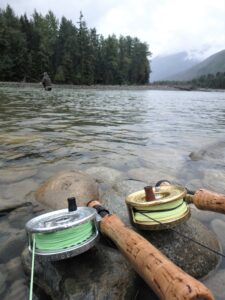 As sink-tip lines have become more popular, line manufacturers have developed many more configurations to help cover any water conditions. The variety of lengths and sink rates are endless. The higher the number on the sink rate the quicker the line will sink. A type 3 will sink at approximately 3 inches per second while a type 6 will sink at six inches per second. The length of tip is a personal preference, but I feel the short tips are more manageable in the current as there is less line being dragged through the current.
As sink-tip lines have become more popular, line manufacturers have developed many more configurations to help cover any water conditions. The variety of lengths and sink rates are endless. The higher the number on the sink rate the quicker the line will sink. A type 3 will sink at approximately 3 inches per second while a type 6 will sink at six inches per second. The length of tip is a personal preference, but I feel the short tips are more manageable in the current as there is less line being dragged through the current.
The Results
Several years ago, while winter steelheading I put all the pieces together and came up with a productive combination. The water I was trying to fish was between four and six feet deep, the only problem was the surface was moving quite quickly. This specific body of water looked so fishy that the next day I returned with a 5ft quick decent sink-tip. With the sinking portion being only 5 feet long I was able to control the floating portion on the surface without a lot of drag on my line. By tossing a couple mends into the line it allowed the fly to drift naturally threw the run. With a three-foot leader and weighted fly pattern it allowed me to run the fly right through the zone. The run I found unfishable the previous day had yielded me two 10-pound steelhead once I efficiently covered the water.
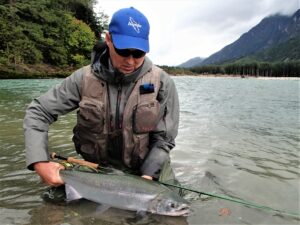 The most common mistake made when fishing rivers with sink-tips is using too long of leaders. I find if a leader is over three feet the fly will remain near the surface while the sink-tip is on the bottom. I now use leaders as short as two feet with using shorter sink- tip lines.
The most common mistake made when fishing rivers with sink-tips is using too long of leaders. I find if a leader is over three feet the fly will remain near the surface while the sink-tip is on the bottom. I now use leaders as short as two feet with using shorter sink- tip lines.
It may take a little practice and patience learning to read moving water, but once you do river fishing is very enjoyable with a new challenge around every bend of the river. I find lake fishing is limited to a few good months per year, but good river fishing can be found year-round in our beautiful province.
-Tom Johannesen


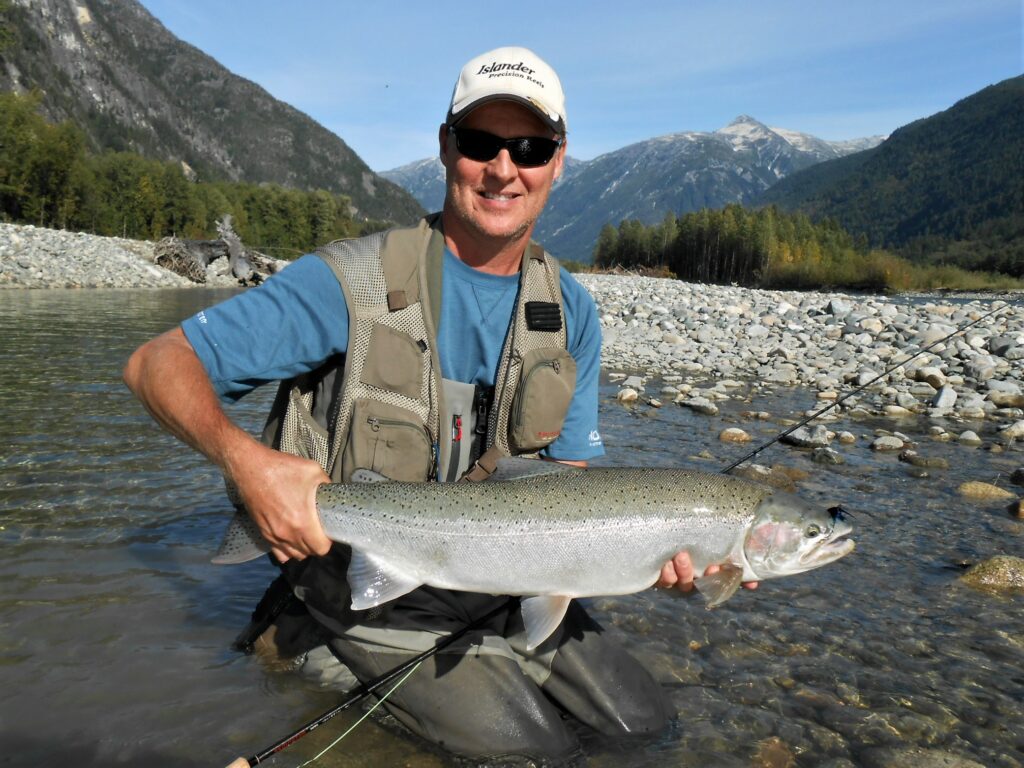
I have an islander fly reel- l x3.8 that is more than 20 years old that I use for Atlantic salmon in Newfoundland,, I just got to tell you it is a fantastic reel, it never let me down or ever gave me a problem, thank you very much- good job, bloody good job